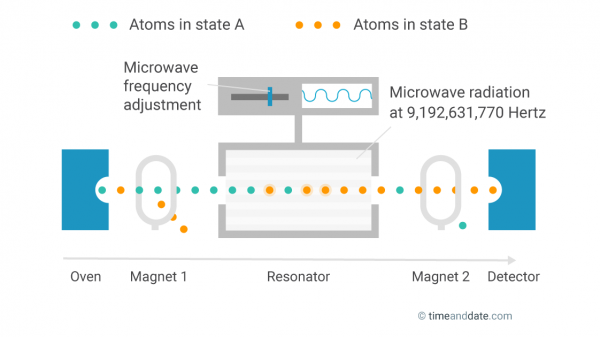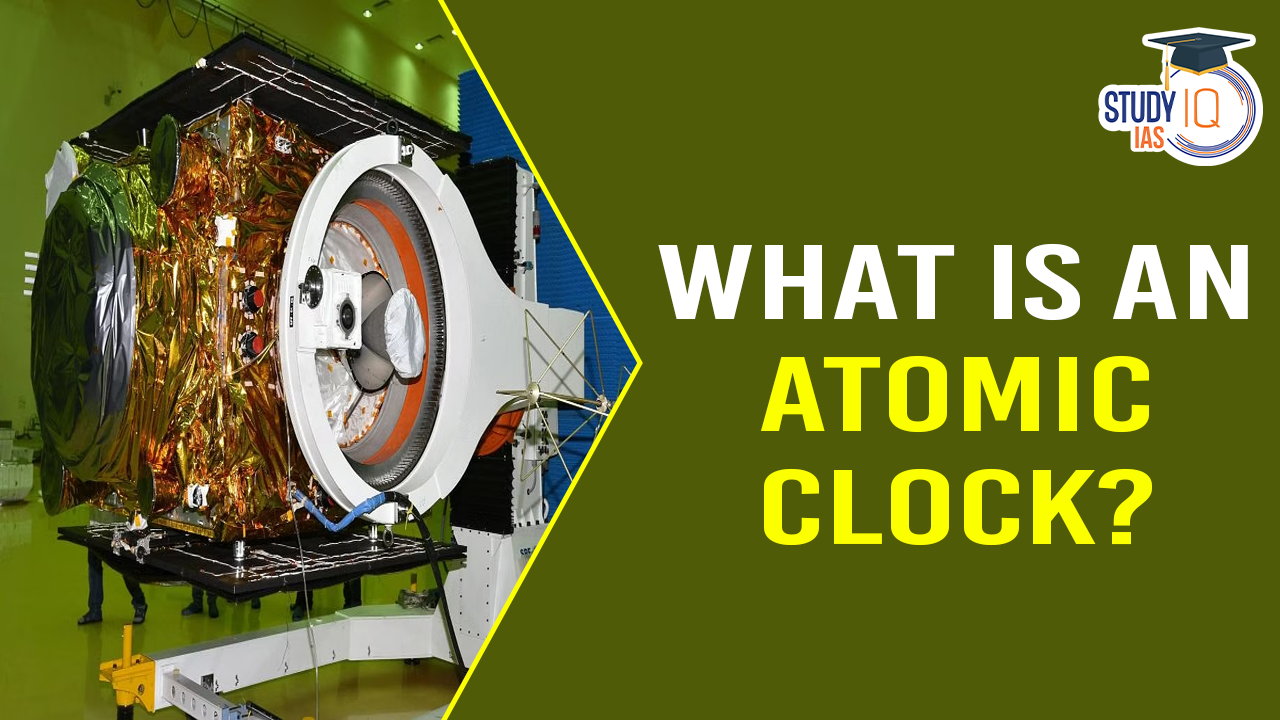Table of Contents
Context: A recent study published in Nature introduced a portable optical atomic clock using molecular iodine as the frequency standard that can be used onboard ships.
What are Atomic Clocks?
- An atomic clock is a highly precise timekeeping instrument that utilises the natural vibrations of atoms to measure time.
- This device leverages the constant frequency of atoms to ensure more stable timekeeping compared to traditional quartz clocks.
- It was invented in 1955 by Louise Essen.
- Currently, only four countries – the United States, the United Kingdom, Japan, and South Korea – have developed their atomic clocks.
Types of Atomic Clocks
- Traditional Atomic Clocks: These utilise atoms such as caesium (Cs-133) to measure time, defining one second as 9,192,631,770 oscillations of the caesium atom.
- Cesium atomic clocks are highly precise and form the primary standard for the second in the International System of Units (SI).
- Rubidium Atomic Clocks: Similar to caesium clocks, rubidium atomic clocks use rubidium atoms for time measurement.
- They are typically smaller, less expensive, and more portable, making them ideal for situations where space and cost are considerations.
- Hydrogen Maser Clocks: Offering even greater precision than cesium clocks, hydrogen maser clocks utilise the hyperfine transition of hydrogen atoms.
- These clocks operate at higher frequencies, providing exceptional short-term stability and accuracy.
- They are frequently used in scientific research, satellite navigation, and space missions.
- Optical Atomic Clocks: These use atoms like strontium or ytterbium, operating at optical frequencies for higher accuracy. They use lasers to stimulate atomic transitions. They are poised for future applications in fundamental physics research and advanced positioning systems.
How Atomic Clocks Work?
- Atomic transitions: Atomic clocks utilise the fundamental property of atoms to jump between different energy levels.
- These jumps are like steps on a ladder, with atoms absorbing energy, such as electromagnetic radiation, to climb up.
- Caesium-133 (Cs-133): A common element in atomic clocks, Cs-133, is a highly stable atom found naturally.
- In Cs atomic clocks, the energy needed for the atom to jump to a higher energy level matches the frequency of microwave radiation, which is precisely linked to the duration of a second.
- Resonance and feedback: The frequency of microwave radiation applied to Cs atoms in a cavity is adjusted until it matches the transition energy, a phenomenon called resonance.
- When 9,192,631,770 oscillations occur between energy levels in Cs-133, one-second passes.
- A feedback mechanism ensures the accuracy of atomic clocks by detecting and adjusting any changes in resonance frequency.

Optical Atomic Clocks Working
- Lasers and coherence: Optical atomic clocks use lasers to stimulate atomic transitions. These lasers emit highly coherent light, meaning all light waves have the same frequency and a consistent relationship between their wavelengths.
- This results in light with precise properties and stability.
- Two factors for accuracy: The higher operating frequency and narrower line widths of optical atomic clocks contribute to their enhanced accuracy.
- Higher operating frequency means more oscillations within a given time frame, allowing for the measurement of smaller increments of time.
- Narrower line widths, referring to the frequency range over which transitions occur, facilitate precise tuning of the optical light frequency, leading to higher accuracy.
- Strontium and ytterbium: Strontium (Sr) is frequently used in optical atomic clocks due to its narrow line widths and stable optical transitions. Indian researchers are working on optical atomic clocks using strontium and ytterbium ions.
Atomic Clock in India
- India aims to deploy its own atomic clocks across the nation, to enhance its timekeeping infrastructure and national defence capabilities for the future.
- Currently, India relies on foreign atomic clocks, particularly those in the US.
Rationale Behind Atomic Clocks Development
- Background: This initiative was started due to the denial of Global Positioning System (GPS) information during the Kargil War in 1999.
- The existence of independent timekeeping capabilities is crucial for defence, cybersecurity, and online transactions.
- Development of Indigenous Atomic Clocks in India: India is advancing its development of atomic clocks to decrease dependence on foreign technology, particularly for crucial systems like the Indian Regional Navigation Satellite System (IRNSS), also known as NavIC.
- Autonomy and Security Benefits: By developing its own atomic clocks, India seeks to maintain full control over its navigation systems.
- This autonomy is critical for national security and promotes technological independence, enhancing the country’s ability to manage and secure its own infrastructure.


 World Immunization Week (24 to 30 April)...
World Immunization Week (24 to 30 April)...
 National Panchayati Raj Day (24th April)...
National Panchayati Raj Day (24th April)...
 Understanding Type 5 Diabetes: The Malnu...
Understanding Type 5 Diabetes: The Malnu...






















